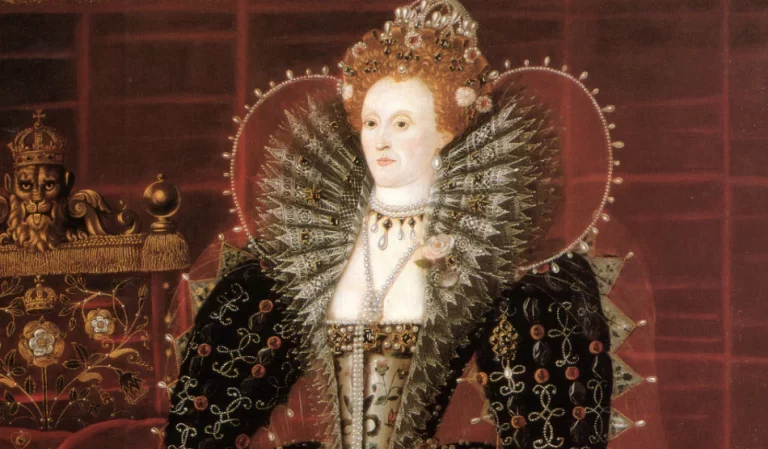
Elizabeth I
Elizabeth I is known as one of the greatest British monarchs. She was the daughter of the infamous King Henry VIII, and the only surviving child of Anne Boleyn. Unfortunately, her mother is recorded in history as Henry VIII’s second wife, who was beheaded for treason. Elizabeth was born on September 7, 1533, and became Queen of England after the death of her older half-sister Mary Tudor in 1558.
When Elizabeth I became queen, she was expected to marry immediately and produce an heir. However, for reasons still unknown, she never married. Instead, she proclaimed herself married to the kingdom of England. As a result, she was forever known as the “Virgin Queen,” which was visually displayed in her royal portraits. Her political power, virginity, and timeless beauty are best portrayed in this portrait at Hardwick Hall.
Visually Vivacious
In an opulent dress covered in jewels and images of flora and fauna, Elizabeth I stands in front of a velvet cloth of state. Upon closer view, the dress is covered in white pearls, which is a symbol of purity. It is unsurprising for pearls to be displayed on a virgin queen’s dress. However, the dress stands out due to the pattern of the land and sea creatures. As the Metropolitan Museum of Art notes, the artist, Nicholas Hilliard, purposely portrayed Elizabeth I as two-dimensional through her preference. As a result, Elizabeth I is illustrated as a young queen with porcelain skin. However, the portrait was made during her late sixties.
But who commissioned this portrait, and what is noteworthy about the petticoat?
Commission
Remarkably, Elizabeth I did not commission the portrait, although she probably admired it when first displayed at Hardwick Hall. Instead, art historians suggest the portrait was commissioned by Elizabeth Talbot, Countess of Shrewsbury (known as Bess of Hardwick). She is remembered as one of the greatest patrons of architecture during the Tudor Age. For instance, her decoration at Hardwick house is considered an Elizabethan “prodigy house.” Meaning it was built during the Tudor Age and was large enough to fit Elizabeth I and her entourage.
It is known that Bess of Hardwick was eager to win the favor of Elizabeth I. And this portrait exemplifies her desire to win favor at the Elizabethan court due to the embroidered petticoat’s design.
Embroidered Impact
Exceptionally, Bess of Hardwick was a masterful embroiderer, which raises the possibility that she embroidered this petticoat for Elizabeth I. The figurative language of flowers embroidered into the Hardwick dress played an important role in the Elizabethan court. Mutually, the bizarre sea monsters mimic the imagery displayed at Hardwick (according to printed sources). Contemporary fashion would have focused more on a geometric design such as the portrait, The Hampden Portrait. But since Bess was obsessed with entertaining the queen, this added detail is predictable.
Overall, the Hardwick portrait is a visual representation of Elizabeth I’s impact on Bess of Hardwick’s desperation for royal favor.
